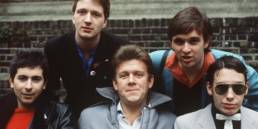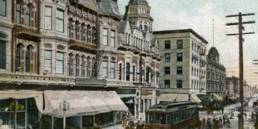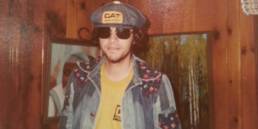
During the late-1960s, with Los Angeles’ skies still blotted by poisonous smog, an angry mother fastened a sign in her station wagon that you never would’ve imagined in the planet’s car capital. “This GM,” her placard read, “is a killing machine.” Intended as an activist war cry, her words by the end of the next decade carried a more diabolical meaning.
Predators were no longer only skulking neighborhood back alleys or through unlatched windows to snatch up their quarry. They were adopting their own vehicles as murder accomplices, exploiting Southern California’s go-anywhere roadways to create distance between themselves and the corpses they left behind. For these dark-eyed sadists, every highway off-ramp presented temptations, every on-ramp a getaway to blend in with thousands of other taillights on concrete stretching into the horizon.
Consider William Bonin, a mustachioed truck driver and ex-Vietnam War helicopter pilot who in 1979 and 1980 stalked young men to abduct, torture, and slaughter in his van. The media gave him an accurate, if sensationalized moniker. The “Freeway Killer,” along with his collaborators, would butcher twenty-one people before being apprehended. Giving himself space to operate with impunity, Bonin once deposited a body just off the Golden State Freeway forty miles from his Downey home southeast of Los Angeles.
Rivaling him in this high watermark era of serial-killers was Angelo Buono Jr., the so-called “Hillside Strangler,” who, together with his cousin snuffed out victims in Buono’s auto upholstery shop in Glendale northeast of LA; sometimes they’d position their victims in lurid poses off local roads to ridicule police. In 1978, a female college student they kidnapped was later discovered in the trunk of her Datsun, which had been shoved over a cliff off mountainous Angeles Crest Highway directly behind my high school.
That same year, while NBC broadcast its series “CHiPs” about fictional California Highway Patrolmen gliding along flyover interchanges and breezy straightaways, two real-life henchmen set out in a green Plymouth to terminate someone hundreds of miles south. Their assassination target was Paul Morantz, a feather-haired lawyer crusading against the group that radicalized them: Synanon, a former drug-and-alcohol detox turned xenophobic cult. In otherwise picture-postcard Pacific Palisades above Santa Monica, the pair stuffed a nearly five-foot-long rattlesnake into the attorney’s mail slot. Despite being bitten on the wrist in a bizarre, attempted homicide by reptile, Morantz survived.
The conclusion, even so, was indisputable: the same steel-and-chrome rides synonymous with West Coast suburbia and personal liberty—the same whitewall models churning never-ending windfalls for Detroit’s carmakers, had betrayed us. Air pollution that experts vowed would be long gone continued to dirty the atmosphere like an ashtray, triggering more deaths from lung diseases, heart ailments and such than gang violence, overseas wars and car accidents combined. It barely ended there. In this era of simmering disillusionment about the post-Watergate American way of life, motorists threw punches waiting in blocks-long lines at gas stations following a Middle East oil embargo. Out on LA’s Westside, drivers incensed by experimental “Diamond Lanes,” which were intended to reward carpoolers in ever-gnarled traffic, hung then-Gov. Jerry Brown’s transportation chief in effigy. Before long, scenes of shattered windows from drive-by shootings in the inner-city would be prosaic on the 5 p.m. news.
Aside from my own teenage run-ins with hotheads practicing road rage before the term was coined, I had no idea that the vicious prowled hunting grounds from the comfort of their bucket seats. It wasn’t until—for a book project—I immersed myself in the drama of Howard Garrett and his rainy-night execution of an upstart interior architect that I realized that 1979 was our season of odometer-fueled discontent.
Garrett, a middle-aged blue collar contractor with a vulturous aura, was defrauded by said architect in a soured partnership. So, he put his steel-blue El Camino front and center in a months-long reign of terror. He’d previously transported inside his camper shell—across crisscrossing freeways—a junkie he had pummeled to death with a rifle butt. By abandoning his burning corpse in scrubland in another county, Garrett knew he’d throw detectives off his scent. He did, repeating this same alibi-by-separation philosophy when he founded a boutique, murder-for-hire corporation focused on real estate executives. To entice “employees” to do his bidding (and also scapegoat, if necessary), he offered them use of his prized Chevy, a half car, half truck with the ground-hugging profile of a bull shark. Anyone in his criminal retinue who borrowed it without permission risked their necks, as if Garrett’s creepiest secrets were welded inside the door panels.
On the evening he decided to accompany his minions to kill his target after they’d bungled the job on multiple occasions, it was the El Camino they drove, traversing at least three freeways—the 10, the 210, and the 101—to reach their destination on a leafy block in the San Fernando Valley. Job completed, they motored north, towards the Magic Mountain amusement park, where the triggerman chucked most of the disassembled murder weapon out the window.
Fittingly, Garrett’s bloody handiwork warranted only a short news brief in the local paper—right below a story about TV-comedian’s Red Foxx’s assault charges. Why? 1979’s record-setting murders, from ritualized killings and professional hits to domestic disputes and gang shootings, made for stiff front-page competition.
Today, the car-reliant predators of the seventies have faded in the limelight, giving way to AR-15-brandishing mass shooters, while the gray-brown airs that had so many coughing is mostly history. In contemporary LA, the real serial killer doesn’t bear a catchy nickname or a police sketch. It’s the climate-warming gases seeping out of almost eight million automobiles here that add to graveyards worldwide by the tens of thousands. “Killing” machines indeed.
This essay is nearly identical to the one that originally ran in CrimeReads.




